Since I am a bit of a hardware enthusiast, I tend to buy new computer hardware a little more often than the average person (probably too often)! I like to have a smaller laptop for teaching and presentations, that is thin and light, but not an actual Ultrabook.
Most current Ultrabooks use the low power versions of Intel processors (such as the Intel Core i5-3317U) which generate less heat and provide better battery life than the standard voltage models such as the Intel Core i5-3210M. On the downside, those low voltage models also give you significantly less performance than the standard voltage models. Another issue with most Ultrabooks is that they only have 4GB (or in some cases 8GB) of RAM, which cannot be upgraded. Finally, many Ultrabooks use small capacity mSATA SSD drives that are difficult or nearly impossible to upgrade.
On the upside, most modern Ultrabooks have higher quality, high resolution screens (often 1600 x 900 or 1920 x 1080), and they are very thin and light (less than 3.3 lbs). They also tend to have higher build quality than lower cost Windows laptops, along with a higher cost.
A couple of years ago, I bought a Toshiba Portege R705-P25 with a 32nm 2.26GHz Intel Core i3-350M “Arrandale” processor and Intel integrated graphics. About a year ago, I bought an externally identical Toshiba Portege R835-P55X with a 32nm 2.3GHz Intel Core i5-2410M “Sandy Bridge” processor, with improved Intel integrated graphics. Finally, a few weeks ago, I bought another externally identical Toshiba Portege R935-P330 with a 22nm 2.5GHz Intel Core i5-3210M “Ivy Bridge” processor, with even better Intel integrated graphics.
Overall, I have been pretty happy with these machines. They have all been special OEM versions that were not configured exactly how I would have preferred, but they have been hundreds of dollars less expensive than the same configuration would have been if I had custom ordered it directly from Toshiba. The biggest weakness in these machines is their pretty mediocre 1366 x 768 screen. I would have happily paid more money for a better quality 1600 x 900 or 1920 x 1080 screen.
In each case, I eventually modified these machines from their original stock configuration by adding more memory, and installing a fresh copy of Windows 7 on a solid state drive (SSD). The older R705-P25 does not have SATA III support, so its disk performance is somewhat reduced with the current 6Gbps SATA III SSDs. Here is the Windows 7 Windows Experience Index (WEI) scores for these three systems after my modifications:
Figure 1: Toshiba Portege R705-P25 with 8GB of RAM and 128GB OCZ Agility 4 SSD
Figure 2: Toshiba Portege R835-P55X with 16GB of RAM and 180GB Intel 520 SSD
Figure 3: Toshiba Portege R935-P330 with 16GB of RAM and 256GB OCZ Vertex 4 SSD
This chart summarizes the WEI scores for all three systems:
| System | Processor | Memory | Graphics | Gaming | Disk |
| R705 | 6.1 | 6.3 | 4.6 | 5.2 | 7.4 |
| R835 | 6.9 | 7.4 | 5.9 | 6.2 | 7.8 |
| R935 | 7.1 | 7.5 | 6.5 | 6.5 | 7.9 |
Table 1: Windows Experience Scores on Modified Systems
On Windows 7, the WEI score has a maximum value of 7.9. The disk score is limited to 5.9 unless you have an SSD installed.
For comparison’s sake, here are the CPU-Z screenshots for all three systems:
Figure 4: CPU-Z CPU screen for Toshiba Portege R705-P25
Figure 5: CPU-Z CPU screen for Toshiba Portege R835-P55X
Figure 6: CPU-Z CPU screen for Toshiba Portege R935-P330
The newer Sandy Bridge and Ivy Bridge processors handle power management differently (and better) than older Intel processors such as the Arrandale. Even when the High Performance power plan is used, the newer Sandy Bridge and Ivy Bridge processors will not run at full speed when they are not under any load, but they will throttle up much more quickly to full speed when they do see a processor load. There is much less of a performance difference between the default Balanced power plan and the High Performance power plan.
Again for comparison’s sake, I ran the 32-bit version of Geekbench 2.3.4 on all three systems. Geekbench only measures processor and memory performance, but it is a useful, quick benchmark for a system, whether it is a laptop or a database server.
Figure 7: Geekbench 2.3.4 score for Toshiba Portege R705-P25
Figure 8: Geekbench 2.3.4 score for Toshiba Portege R835-P55X
Figure 9: Geekbench 2.3.4 score for Toshiba Portege R935-P330
What I find interesting about this is the very large jump from the Arrandale in the R705 to the Sandy Bridge in the R835 (at roughly the same clock speed), showing the effects of a full Intel Tock release. Moving from the Sandy Bridge in the R835 to the Ivy Bridge in the R935 is much smaller, and a good portion of this small improvement is due to the increased 2.5GHz clock speed in the Ivy Bridge compared to the 2.3GHz clock speed in the Sandy Bridge. Intel calls the Ivy Bridge a “Tick plus” release, since they made more substantial improvements in the integrated graphics performance in Ivy Bridge.
| System | Geekbench Score | % Increase |
| R705-P25 | 3911 | |
| R835-P55X | 5894 | 50.7% |
| R935-P330 | 6620 | 12.3% |
Table 2: Geekbench score comparison
Finally, I ran CrystalDiskMark 3.0.1 on all all three systems, using the default file size of 1000MB. Figure 10 shows the results for the Toshiba Portege R705-P25. Note: I made a mistake when I typed in the model of the SSD in Figure 10. It is actually a 128GB OCZ Agility 4 SSD that is plugged into a slower SATA II port, which limits its sequential read and write performance.
Figure 10: CrystalDiskMark for 128GB OCZ Agility 4 SSD in SATA II port
Figure 11: CrystalDiskMark for 180GB Intel 520 SSD in SATA III port
Figure 11 shows the results for the Toshiba Portege R835-P55X. Note that the Intel 520 SSD uses the SandForce 2281 controller which compresses data before it is written. The default setting in CrystalDiskMark uses a data file which is filled with random data, which does not compress well, which affects the performance quite a bit in this test.
Figure 12: CrystalDiskMark for 256GB OCZ Vertex 4 SSD in SATA III port
Figure 12 shows the results for the Toshiba Portege R935-P330. The controller used in the OCZ Vertex 4 SSD does not use compression. This particular SSD was updated to use the latest 1.5 firmware. This SSD is showing much better performance in this bench mark that the other two SSDs.
In case you are wondering why I have three externally identical laptops, it turns out that I have recently given the older R705-P25 to one of my nieces, and I will probably give the R835-P55X to another niece. Sometimes my family jokes that my hand-me-down computers are better than many people’s new machines.

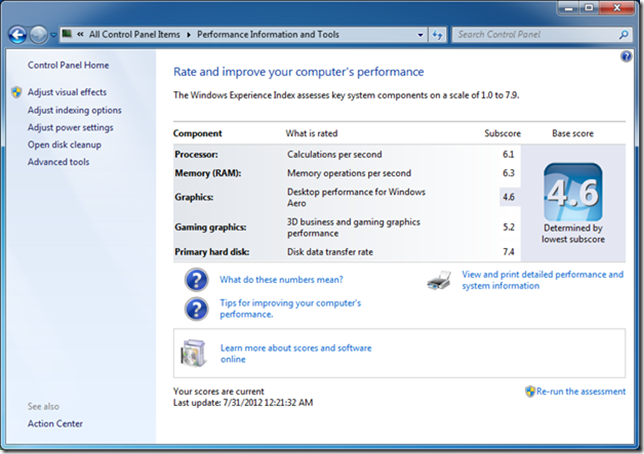
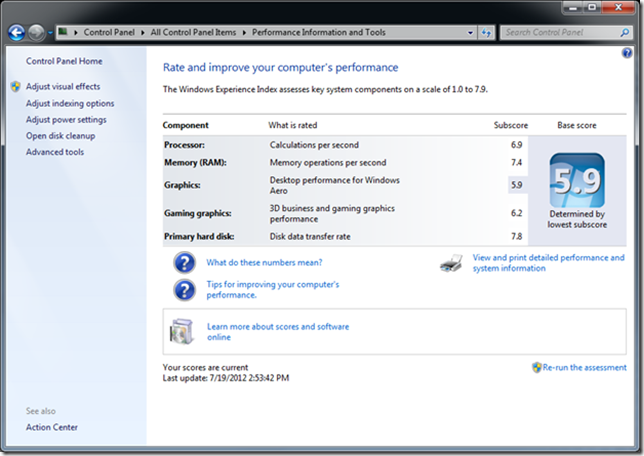

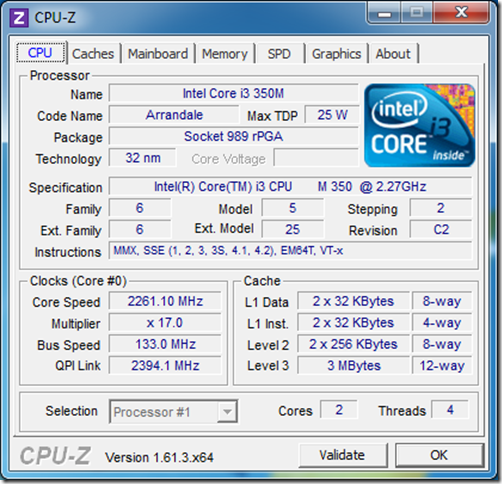


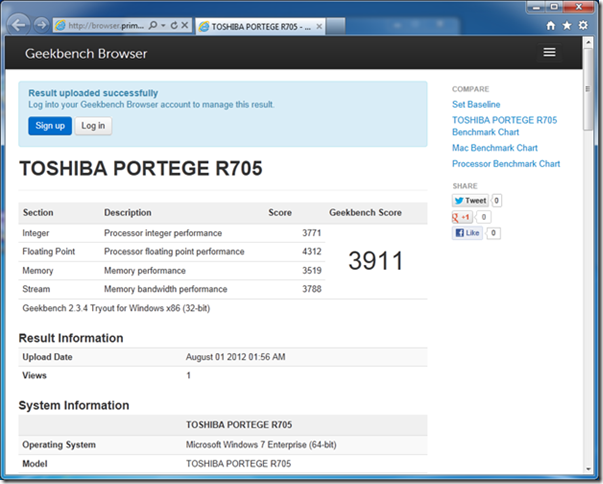

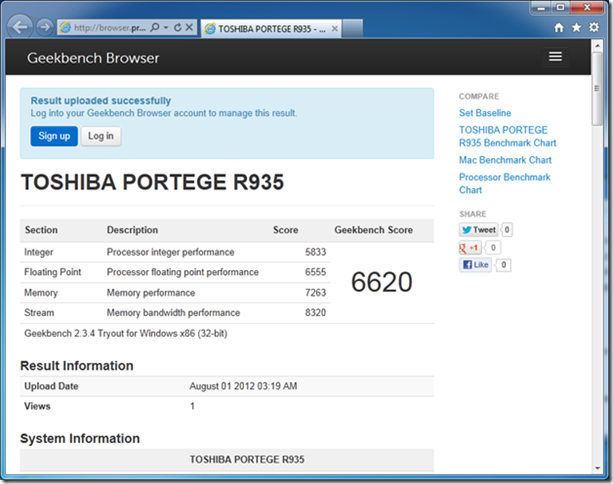
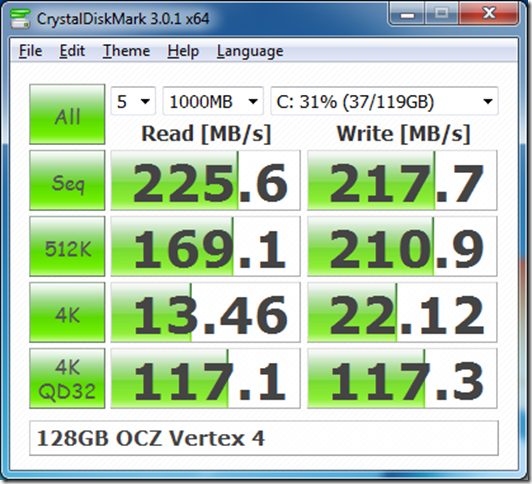


Glenn, I have that same R705 laptop, which was a BB special edition. Still love it; was wondering if I should drop $100-150 on a SSD for it, and seeing the tests above, I have to conclude that it might be worth it. Still love the Widi external display, decent keyboard, and the superlight form factor. A SSD might get me to the 4th generation Intel core. Feel you on the resolution though; 1600×900 resolution will tip the balance for me towards a new purchase. Especially working in SQL and with multiple remote desktop sessions. Higher than that might be a bit much for a 13 inch screen. Wish they would bring back the 1600X1200 as a pro option; I miss those 300 vertical pixels.
I would get an SSD for that unit. Even with the older SATA II connection, you will still see better performance than with a conventional hard drive.
I did get an Intel 520; impressive performance bump. I can now open all of my common applications at the same time. Battery life is improved and the laptop runs cooler than ever. I did elect to rebuild the OS instead of using the cloning utility. VMs are now amazingly stable as well. Great post, thank you for planting the bug in my ear.
Glad to be able to help a little!
All the specs I find online for the two newer Toshibas say that 8GB of memory is the maximum recommended and to Toshiba Online rep just confirmed that. I’d like to do that but how did you get to 16GB and what memory did you use for the R935? Thanks.
The Toshiba rep is wrong, unfortunately. The Sandy Bridge and Ivy Bridge processors have integrated memory controllers that support up to 8GB sticks of DDR3 RAM. These Toshiba models have two slots, so 2 x 8GB = 16GB. I used Corsair Vengeance http://www.newegg.com/Product/Product.aspx?Item=N82E16820233265
One other thing to check is Windows7 version. Home Basic SKU is physically limited to 8GB , Home Premium to 16GB so a lot of manufacturers list that as the Max Memory . Spend $89 to upgrade to Professional and you can remove that limit and install as much memory as the CPU/MB supports
More here:
http://msdn.microsoft.com/en-us/library/aa366778%28VS.85%29.aspx
Brilliant. Worked like a charm getting me to 16GB. Another question: What is the largest SSD that you might suggest for the Toshiba Protege R935, i.e., GBs and Inches?
You can get 512GB SSDs from a number of different companies. I like the OCZ Vertex 4. It is possible to get a larger SSD, but they are extremely expensive and don’t really make economic sense
Dear bro , could you comment please on the following: (ivy bridge model only)
1- temperature
2- fan noise
3- sound
4- battery life
and i wish you could post the pcmark vantage or pcmark 7 or both for the ivy bridge model . regards and many thanks
Pingback: The Dream Machine « Voice of the DBA
How about an update on the laptop(s) you are using now. Your earlier comments were spot on and I’d be interested in your recommendations especially for ultra books. Thanks
Hi,
I read your reviews, pretty helpful. Thanks for that. I would like to comment though that the R835’s have a problem of the SATA port being limited to SATA2 speeds by Toshiba’s bios. Its a big issue. there has been many big forums, complaints and efforts about making toshiba to take this limit off from their bios. Toshiba reps have usually replied by saying that they would do that if their models came with SATA3 SSD’s. Do you have any comments on this. Have you gotten any SST to show SATA3 speeds on your R835 ever? Since you seem to hae many kinds of SSD’s you can probably try.
Thanks
I don’t have my R835 any longer, but I think that I was seeing SATA III speeds from it (if memory serves). If there is a problem there, I would not hold that much hope of Toshiba fixing it, since that model is long out of production now.
I’ve used Toshiba laptops exclusively for at least 20 years and been quite pleased. Your advice on upping my memory to 16GB when Toshiba said 8GB was outstanding. Now I’m ready to upgrade again from a Portege R30. I’m interested in knowing what kind(s) of laptops you now use and recommend especially the ultrabooks. Thanks.